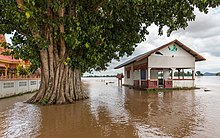Climate risk insurance
Climate risk insurance is a type of insurance designed to mitigate the financial and other risk associated with climate change, especially phenomena like extreme weather.[1][2] The insurance is often treated as a type of insurance needed for improving the climate resilience of poor and developing communities.[3][4][5] It provides post-disaster liquidity for relief and reconstruction measures while also preparing for the future measures in order to reduce vulnerability.
Critics of the insurance, say that such insurance places the bulk of the economic burden on communities responsible for the least amount of carbon emissions.[4] For low-income countries, these insurance programmes can be expensive due to the high start-up costs and infrastructure requirements for the data collection.[6] It is theorised that high-premiums in high risk areas experiencing increased climate threats, would discourage settlement in those areas.[1] These programmes are also usually timely and financially inadequate, which could be an uncertainty to national budgets.[6] A considerable problem on a micro-level is that weather-related disasters usually affect whole regions or communities at the same time, resulting in a large number of claims simultaneously.[7] This means that it is needed to be sold on a very large, diversified scale.[7] However a well-designed climate risk insurance can act as a safety net for countries while improving resilience.[5][8]
The international community invested in developing further support for this kind of insurance through the launched at COP23.[4] That group, supports regional programs such as (CRAIC) and international organizations like the .[4] The ACT Alliance published a guidebook for equitable and climate justice oriented model for climate risk insurance in 2020.[9]
Types of climate risk insurance[]
Flood insurance[]

The rising climate change related risks, such as sea level rise, floods and windstorms, threaten the livability and affordability of the impacted areas.[10] This is why one of the more widely used forms of climate risk insurance is flood insurance, which provides coverage against loss caused by flooding.[10]
References[]
- ^ a b "7 things you need to know about climate risk insurance - Institute for Environment and Human Security". ehs.unu.edu. Retrieved 2020-11-08.
- ^ Hermann, Alexandra; Koferl, Peter; Mairhofer, Jan Phillip (September 2016). Climate Risk Insurance: New Approaches and Schemes (PDF). Allianz.
- ^ MAKING CLIMATE RISK INSURANCE WORK FOR THE MOST VULNERABLE: SEVEN GUIDING PRINCIPLES (PDF) (Report). MUNICH CLIMATE INSURANCE INITIATIVE. 2016.
- ^ a b c d Welle (www.dw.com), Deutsche. "Climate risk: Insuring against the inevitable | DW | 07.12.2018". DW.COM. Retrieved 2020-11-08.
- ^ a b Surminski, Swenja; Bouwer, Laurens M.; Linnerooth-Bayer, Joanne (April 2016). "How insurance can support climate resilience". Nature Climate Change. 6 (4): 333–334. doi:10.1038/nclimate2979. ISSN 1758-6798.
- ^ a b Verfasser, Warner, Koko. Innovative Insurance Solutions for Climate Change How to integrate climate risk insurance into a comprehensive climate risk management approach. OCLC 950715797.
{{cite book}}:|last=has generic name (help) - ^ a b Hermann, Alexandra (September 2016). "Climate Risk Insurance: New Approaches and Schemes" (PDF). Archived (PDF) from the original on 2020-11-13.
- ^ Kreft, Soenke (November 2017). "Climate Risk Insurance for Resilience: Assessing Countries' Implementation Plans" (PDF). Archived (PDF) from the original on 2019-12-20.
- ^ "Climate Risk Insurance and Risk Financing in the Context of Climate Justice - A Manual for Development and Humanitarian Aid Practitioners - World". ReliefWeb. Retrieved 2020-11-08.
- ^ a b Cremades, R.; Surminski, S.; Máñez Costa, M.; Hudson, P.; Shrivastava, P.; Gascoigne, J. (January 2018). "Using the adaptive cycle in climate-risk insurance to design resilient futures". Nature Climate Change. 8 (1): 4–7. doi:10.1038/s41558-017-0044-2. ISSN 1758-6798.
- Climate change adaptation
- Climate justice
- Climate change stubs